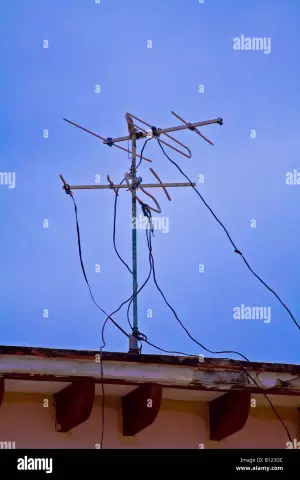In order for the TV to start receiving channels, it is not enough just to bring it into the room and turn it on. An antenna must also be connected to it. The number of received channels and the quality of their reception depends on its correct choice.
Instructions
Step 1
Remember the main rule: if the braid of the antenna cable is grounded (if the antenna is collective, this is always the case, and often it is also grounded for individual outdoor antennas), simultaneously touch the metal elements of the TV plugged into the outlet and the plug, when they are not connected to each other, you can't! Also, do not touch the metal parts of two devices that are plugged into an outlet and not connected to each other (for example, a TV and a DVD player), as well as the cables connected to them, even if the antenna is not grounded. In addition, do not touch the metal parts of the TV and any video equipment, as well as the antenna cable and telescopic antenna if your body has acquired an electrostatic charge from the CRT screen (for example, during wiping). Never install an outdoor antenna yourself if you are not sure if you can provide reliable lightning protection. Solder any grounded antenna cables only with properly insulated soldering irons.
Step 2
In order to connect a single-pin telescopic antenna built into it to the TV, insert the plug coming out of the body of the device on the wire into its antenna socket. If there are two jacks that correspond to different ranges, move this plug to the jack that corresponds to the range in which you are currently receiving.
Step 3
If the TV also comes with a ring antenna, connect the built-in telescopic antenna to the jack corresponding to the meter wave range, and the ring antenna to the jack corresponding to the decimeter wave range. For some TVs, the second antenna will stick directly to the socket, while for others it will have to be fixed on the first.
Step 4
If the TV comes with a two-pin telescopic antenna, screw a special adapter-matching adapter to the clamps of the symmetrical ribbon cable coming out of it, if this has not been done before. Then connect the adapter to the antenna jack of the TV (such devices usually have one).
Step 5
If the indoor or outdoor antenna is all-wave, and the TV has separate inputs for the MV or UHF antennas, use a splitter. Likewise, if your TV has an all-wave antenna input, and you have two separate MV and UHF antennas, use a splitter splitter. Both are available at hardware stores.
Step 6
To connect one antenna to several TVs, use another device called CRAB (consumer household cable splitter). It is also sold at hardware stores. This device works best with a collective antenna.
Step 7
To use the aerial with amplifier, after connecting it to the TV, plug the power supply into the outlet. Unplug it at the same time as your TV.
Step 8
satellite receiver. To connect it, almost no special knowledge is needed (everything is described in the instructions and on thematic sites), but they will be required to successfully aim the "dish" at the satellite.






